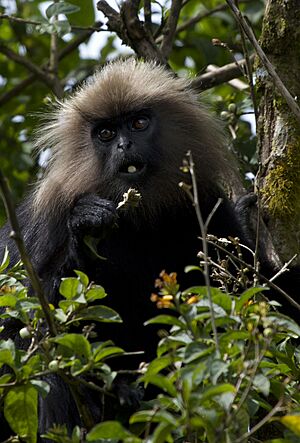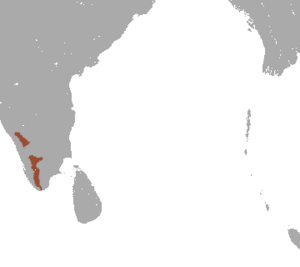Nilgiri langur facts for kids
Quick facts for kids Nilgiri langur |
|
|---|---|
 |
|
| Nilgiri langur eating fruit. | |
 |
|
| At Parambikulam. | |
| Conservation status | |
| Scientific classification | |
| Genus: |
Semnopithecus
|
| Species: |
johnii
|
 |
|
| Nilgiri langur range | |
| Synonyms | |
|
|
The Nilgiri langur (Semnopithecus johnii) is a type of langur monkey found in Asia. It has shiny black fur and a cool orangey-brown 'mane' on its head. Female langurs have a white patch on their inner thigh. These monkeys usually live in groups of about 9 to 10. They eat fruits, young plant shoots, and leaves.
The Nilgiri langur is listed as vulnerable, meaning it's at risk of disappearing. It's threatened by places where they live being destroyed. It is also threatened by poaching (illegal hunting) for their body parts. Some people wrongly believe these parts have special powers.
Contents
About the Nilgiri Langur
The Nilgiri langur is a kind of Old World monkey. These monkeys are known for their long tails and often live in trees.
What They Look Like
Adult male Nilgiri langurs are about 78 to 80 centimeters (about 30-31 inches) long from head to body. Females are a bit smaller, around 58 to 60 centimeters (about 23-24 inches). Their tails are very long, measuring between 68.5 and 96.5 centimeters (about 27-38 inches).
Males weigh between 9.1 and 14.8 kilograms (about 20-33 pounds). Females weigh a bit less, from 10.9 to 12 kilograms (about 24-26 pounds).
Where They Live
The Nilgiri langur lives in the Nilgiri Hills of South India. You can find them in forests at heights of 300 to 2000 meters (about 980 to 6,560 feet). They live in the Indian states of Karnataka, Kerala, and Tamil Nadu.
They have been seen in many protected areas. These include Anamalai Tiger Reserve, Bandipur National Park, and Periyar National Park. They also live in Silent Valley National Park and Eravikulam National Park.
How They Live and Grow
Nilgiri langurs live in social groups. Their diet is mainly plant-based. They enjoy eating fresh fruits, young shoots, and various leaves.
Reproduction and Young
The exact time a baby langur stays inside its mother (called the gestation period) isn't fully known. Scientists believe it's around 200 days.
Images for kids



